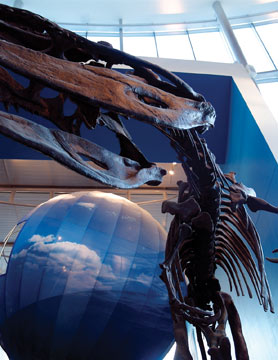|
NEWS NOTES
Teen pregnancy in dinosaurs a good thing
 Mary Caperton Morton |
| Tyrannosaurus rex and other dinosaurs procreated early in adolescence, unlike their avian descendants. |
Teenage pregnancy may be frowned upon today, but new evidence suggests that dinosaurs may have actually gained an evolutionary edge by reproducing in early adolescence. The recent discovery of a rare type of bone tissue called medullary bone in young dinosaurs indicates that some species reached sexual maturity long before they were full-grown adults.
Dinosaur bones, much like trees, exhibit growth rings. By studying these rings under a microscope, scientists can estimate a dinosaur’s age and size at its time of death. Several years ago, researchers Andrew Lee of Ohio University and Sarah Werning of the University of California at Berkeley, were counting growth rings in dinosaur leg bones when they noticed an unusual layer of tissue embedded in the outermost rings of two specimens. They were unable to identify the mystery tissue, but concluded that the Allosaurus they were studying was about 10 years old and the Tenontosaurus was 8 years old — well short of their 30-year average lifespan — when they died and their bones were fossilized millions of years ago.
In 2005, Mary Schweitzer of North Carolina State University in Raleigh announced the first definitive method of sexing dinosaur fossils. The key was medullary tissue she found in the thigh bone of a young, relatively small Tyrannosaurus rex. This tissue is more commonly associated with the contemporary relatives of dinosaurs, modern birds. In birds, medullary bone serves as a reservoir for the large amounts of calcium needed to make eggshells, so the tissue only appears in the bones of females shortly before they lay eggs.
To date, this is the only method of telling the males from the females apart in most dinosaur species. Unfortunately, medullary bone is exceedingly rare as it represents a very narrow window of biological time, perhaps only a few days or weeks, Lee says. Females must die immediately before or during egg laying for the sex-determining medullary tissue to be preserved, he says. When Lee and Werning heard about Schweitzer’s discovery, they raced back to their specimens, Lee says. Sure enough, the mystery layer was medullary tissue: The Allosaurus and Tenontosaurus specimens were both female and in the process of reproducing when they died, Lee and Werning announced during the annual meeting of the Society for Vertebrate Paleontology in Austin, Texas, in October.
Little is known about how dinosaurs reproduced, but early reproduction does make sense in light of how dinosaurs grew, Lee says. New evidence indicates young dinosaurs grew constantly and went through rapid growth spurts during adolescence, putting on several pounds each day. Even so, it took the larger species as long as 20 years to reach full size. So, if dinosaurs waited until they were full grown to start reproducing, they would only have five to 10 years left of fertility.
This pattern of growth and sexual maturation is decidedly different from birds, despite their ancestral link to dinosaurs, Lee says. Although birds are among the fastest-growing animals on the planet, they delay reproduction for years after reaching full size while they develop their plumage, foraging skills and flight muscles. But in dinosaurs, early reproduction may have been widespread. Tyrannosaurus rex and Allosaurus are closely related meat eaters, but Tenontosaurus is a plant eater from the duck-bill family. Evidence of early maturation, though not medullary bone, has also been documented in Oviraptors, a smaller species that belongs to yet another branch of dinosaurs. It is likely other species of dinosaur also reproduced before they were full grown, though fossilized medullary bone proof will be hard to come by, Lee says.
Paleontologist Kristi Curry-Rogers of the Science Museum of Minnesota, who has studied Oviraptor nests, points out that distant relatives sharing this adaptation indicates that adolescent egg-laying was a trait that must have evolved early in the dinosaur family tree. So for dinosaurs, teenage pregnancy was not only a good thing, it may have been part of the secret of their success.

 Subscribe
Subscribe


